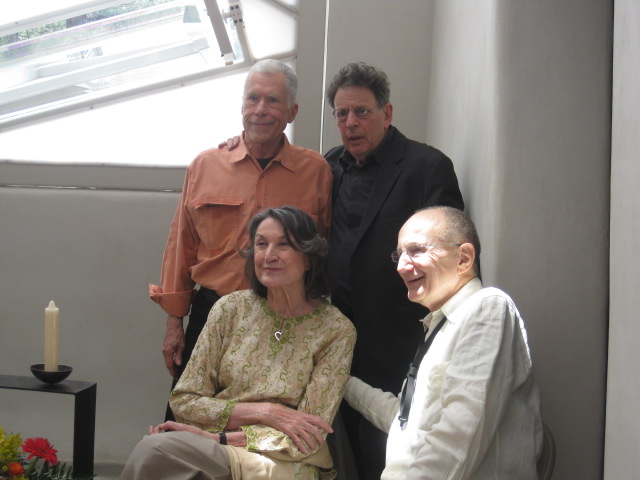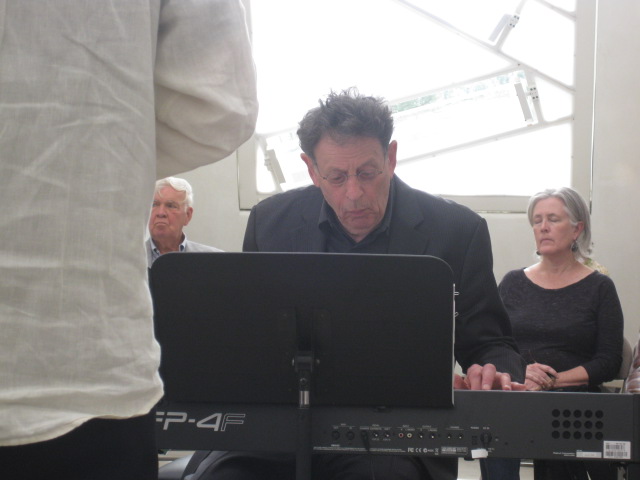
Philip Glass and Jon Gibson Perform at Dwan Light Sanctuary
The maxim holds true: There is no substitute for experience. And when it comes to modern music the experience can be transformative, as well as (at other times) difficult, enrapturing, sometimes irritating, and raising an expectation that somehow, in your hard-backed chair, one day if not today, you might be confounded by dissonance.
It was all rapture on April 5, a Thursday at 3 p.m., with the light scudding from overcast to prismatic, as Philip Glass and Jon Gibson performed a 90-minute concert at Dwan Light Sanctuary. (Featured image: Back row; Charles Ross, Philip Glass. Front row: Virginia Dwan, Jon Gibson.)
 On the
On the New Mexico Highlands University United World College-USA campus, the Dwan Light Sanctuary is named for patron Virginia Dwan, who was there wearing a pale ecru suit and celander scarf. The duo of performers, Jon Gibson and Philip Glass, who on April 4th performed a similar program at Highlands University chapel, wore, respectively, a beige linen shirt, and, a bespoke black suit.
Gibson stood first and selected his instrument, a saxophone, with which to play Companion Piece. He blew twice into the mouthpiece and the exhalation made the impression of a ceremonial opening, an invocation perhaps on Maundy Thursday amid northern New Mexico’s quiescent ghosts. In the first-part of the four-part program, the men each performed solos, Philip Glass leading his offerings with the moody and cascading Metamorphosis #2. I tried composing poetry in the head to pace the fluttery and beatings of the start. Together they played the next two pieces: Chorale From Relative Calm, and Facades.
Some program deviation began gently in part 2, with Glass adding Metamorphosis #3 to the order. The Building, from Einstein on the Beach, marked the first of three songs played from that opera, including The Balcony and The Bed. Robert Wilson’s 1976 opera (Lucinda Childs, dancer), Einstein will be reprised in fall this year, which marks Glass’s 75th birthday, with performances at Brooklyn Academy of Music and in Berkeley. One could intuitively sense Glass’s relationship to modern art, and even a quick vision of Rauschenberg’s Rebus floated across my imagination as he intoned the names of the sections: “The Balcony.”
In all the music lifted and paused and ran and, in Jon Gibson’s serious case, held notes on the air in ways that changed the expressions on the faces of fellow audience members sitting at other arcs of the round chapel. Score marks on the floor led to the players’ feet, under their keyboard or gently holding aloft the breathing body, as in Jon Gibson’s case. And artist Charles Ross’s prisms lent to a constant light play in which spectral waves and undulating illuminations traveled, at one point settling across the back of a blue and white striped shirt, in a very fluorescent way.
 For many New Mexicans (not to mention the world over) it goes without saying that the movie Koyaanisquatsi (first film of the Qatsi trilogy, by Godfrey Reggio), for which Glass composed the music, is religious experience. Glass has written many other movie scores including for one of my top 10s, Peter Weir’s The Truman Show. Lately he has unveiled Book of Longing and an opera, Appomattox, about the end of the Civil War. His newest opera for Linz 2009 was based on Johannes Kepler’s life and work.
For many New Mexicans (not to mention the world over) it goes without saying that the movie Koyaanisquatsi (first film of the Qatsi trilogy, by Godfrey Reggio), for which Glass composed the music, is religious experience. Glass has written many other movie scores including for one of my top 10s, Peter Weir’s The Truman Show. Lately he has unveiled Book of Longing and an opera, Appomattox, about the end of the Civil War. His newest opera for Linz 2009 was based on Johannes Kepler’s life and work.
Dwan Light Sanctuary is a nondenominational chapel (vision and patronage: Virginia Dwan; architecture: Laban Wingert; prisms: Charles Ross). Last week being Holy Week in New Mexico, the musical experience was of intense gladness, on hearing the poignant and glorious music of two of the world’s greatest.

Jon Gibson
Gibson plays multiple wind instruments (flute, clarinet, sax) as well as being a composer. He is also a visal artist and performs with likes of Steve Reich, Terry Riley and LaMonte Young, as well as Glass.
http://www.youtube.com/watch?v=OnlROJ6I2UY
He has often composed and performed with dancers and now works with Nina Winthrop Dance Company and dancers Elisabetta Vittoni and Hetty King. He composed a piece about the inventor Nicola Tesla, Violet Fire. See Jon Gibson dot net for a full bio.
